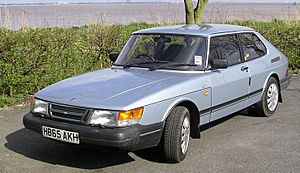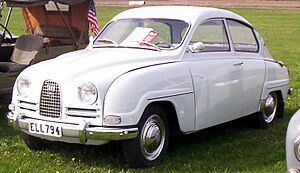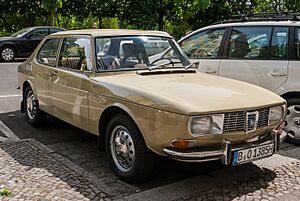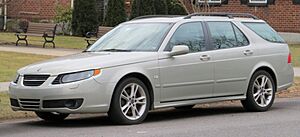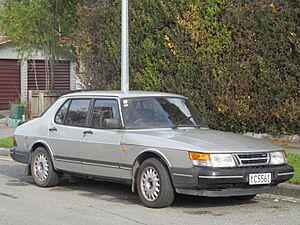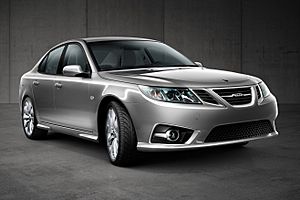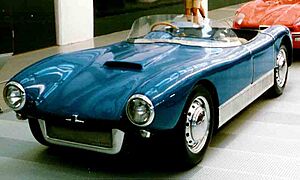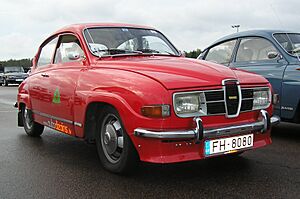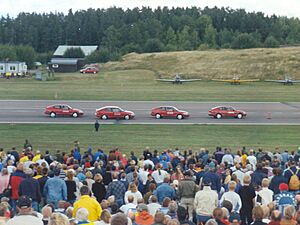Saab Automobile facts for kids
 |
|
| Division | |
| Industry | Automotive |
| Fate | Bankrupt |
| Successor | NEVS |
| Founded | 1945 |
| Founder | Saab AB |
| Defunct | 2016 |
| Headquarters | , |
|
Area served
|
Worldwide |
| Products | Automobiles |
| Parent | Saab AB (1945–1968) Saab-Scania (1968–1990) General Motors (1990–2010) Spyker N.V. (2010–2012) NEVS (2012–2014) |
| Divisions | Saab Aero |
Saab Automobile AB was a car manufacturer from Sweden. It started in 1945 when its parent company, Saab AB, decided to design a small car. The first car, the Saab 92, came out in 1949.
In 1968, the parent company joined with Scania-Vabis. Ten years later, the Saab 900 was launched. It became Saab's most popular model. The new Saab 9000 also appeared in the mid-1980s.
In 1989, Saab's car part became its own company, Saab Automobile AB. The American company General Motors (GM) bought 50 percent of it. During this time, the Saab 9-3 and Saab 9-5 models became well-known. In 2000, GM bought the rest of the company. Then, in 2010, GM sold Saab Automobile AB to a Dutch carmaker called Spyker Cars N.V..
Saab was known for its strong engineering and became a luxury car brand. However, it struggled to attract enough customers. In 2011, the company faced serious money problems. It filed for bankruptcy after a Chinese group's attempt to buy it failed. GM, the former owner, blocked the sale. They did not want their technology to go to a Chinese company.
On June 13, 2012, a new company called National Electric Vehicle Sweden (NEVS) bought Saab Automobile's assets. NEVS started making the Saab 9-3 again in December 2013. These were petrol-powered cars, meant to get the production lines working again. NEVS also planned to develop new electric cars. However, NEVS lost the right to use the Saab name in 2014. The original aerospace company still owns the name. NEVS later produced electric cars based on the Saab 9-3, but under its own "NEVS" brand.
Contents
History of Saab Cars
Saab started as an airplane company. It was called "Svenska Aeroplan Aktiebolaget" (Swedish Aeroplane Corporation). It was created in 1937 in Linköping, Sweden. The company built planes for the Swedish Air Force during World War II. After the war, they looked for new products as plane demand slowed down.
Early Car Designs (1945–1969)
In 1945, Saab began a car design project called "Project 92." The number 92 came after their aircraft, the Saab 91. In 1948, Saab moved its car manufacturing to Trollhättan. This city has been its car home ever since.
Saab built four prototype cars called "Ursaab" (original Saab). The first production model, the Saab 92, was launched in 1949. About 20,000 of these cars were sold by the mid-1950s.
The Saab 92 was updated in 1955 and renamed the "Saab 93." It got a new three-cylinder engine. A wagon version, the Saab 95, was added in 1959. Saab also made its first sports car, the Saab 94, part of the Saab Sonett series.
In 1960, the Saab 96 was released. This car was very important for Saab. It was the first Saab widely sold outside Sweden. The 96 was popular, selling nearly 550,000 units. These cars had unique features like a 3-cylinder engine and front-wheel drive.
The Saab 99 came out in 1968. This was Saab's first completely new car in 19 years. It introduced many new features that became Saab trademarks. These included a special wraparound windshield and strong side-impact door beams. Its design was also very modern for its time.
Joining Forces with Scania (1969–1989)
In 1969, Saab AB merged with Scania-Vabis AB, a Swedish truck and bus maker. They formed Saab-Scania AB.
The Saab 99 line grew in 1973 with a "combi coupe" model. This car style became very popular for Saab. In 1976, Saab produced its one millionth car.
Saab worked with Fiat in 1978. They sold a Lancia Delta car as the Saab 600. They also worked together to create a new car platform. This led to the Saab 9000 in 1985. The 9000 was Saab's first true luxury car.
The Saab 900 replaced the 99 in 1978. Almost one million 900s were made. It became Saab's most famous and best-selling model. A popular convertible version came out in 1986. Many people still love the "classic 900" today.
General Motors Takes Over (1989–2010)
In 1989, Saab's car division became a separate company, Saab Automobile AB. General Motors (GM) and Investor AB each owned 50%. GM invested a lot of money and had the option to buy the rest later.
GM's involvement led to a new 900 in 1994. This car shared parts with the Opel Vectra. Saab made a profit in 1995, its first in seven years. However, this new 900 never gained the same loyal fans as the old one.
In 1997, Saab celebrated 50 years of making cars. They launched the Saab 9-5 to replace the older 9000. The 900 also got an update and was renamed the Saab 9-3. The 9-5 was the first Saab in 20 years without a combi coupe option. Instead, a wagon version was introduced in 1999.
In 2000, GM bought all remaining shares of Saab. This made Saab a fully owned part of GM.
The close relationship with GM led to the new 9-3 in 2003. This model was a sport sedan and dropped Saab's famous hatchback. It shared a platform with the Opel Vectra.
GM also tried to boost sales by introducing the Saab 9-2X (based on the Subaru Impreza) and Saab 9-7X (based on the Chevrolet Trailblazer) in 2005. These models did not sell well and were stopped a few years later. GM also made other decisions that affected Saab's future.
By 2008, GM faced financial difficulties. They announced that the Saab brand was "under review," meaning it might be sold or closed. Saab went into a form of administration, similar to bankruptcy.
Several companies showed interest in buying Saab. In June 2009, Koenigsegg, a sports car maker, announced plans to buy Saab from GM. This deal had support from investors and a Chinese carmaker. However, the deal fell apart in November 2009 due to delays and difficulties.
In December 2009, a Chinese car manufacturer, BAIC, bought the rights and equipment for older Saab 9-3 and 9-5 models. This deal helped Saab stay afloat for a few months. GM then announced that Saab would be closed if no buyer was found by the end of 2009.
Spyker Takes Over (2010–2011)
On January 26, 2010, GM agreed to sell Saab to Spyker N.V., a Dutch carmaker. The sale was completed on February 23, 2010. GM continued to supply engines and parts to Saab. The deal included a loan guaranteed by the Swedish government.
However, in early 2011, Saab started running out of money again. Spyker could not cover the losses. Production at Saab's factory in Trollhättan stopped on April 5.
Spyker's CEO, Victor Muller, tried to find new funding. He tried to get a Russian banker, Vladimir Antonov, to invest. But the European Investment Bank denied this due to concerns.
Later, plans for a joint venture with Chinese carmakers Hawtai and then Youngman and Pang Da emerged. These deals also faced problems. GM announced it would not allow its technology licenses to be used if Saab was sold to the Chinese partners. GM stated this was not in the best interest of its investors.
With no other options, Saab officially filed for bankruptcy on December 19, 2011. This ended a three-year struggle to survive.
National Electric Vehicle Sweden (2012–2014)
On June 13, 2012, a Chinese group called National Electric Vehicle Sweden (NEVS) bought Saab Automobile's assets. NEVS planned to build only electric cars. They aimed to release an electric version of the 9-3 model. GM still refused to license technology for the Saab 9-5 and 9-4X, so these models would not be made.
In August 2012, Scania AB said that NEVS could not use the griffin logo. This logo was used by both Scania and Saab Automobile. Scania worried the logo might be misused in China.
In January 2013, NEVS announced a new deal with a Chinese investment company. This deal would bring more money and a production facility in China.
On August 12, 2013, the Saab plant in Trollhättan reopened. Production of the petrol version of the Saab 9-3 resumed in December 2013. Sales focused on the Swedish and Chinese markets. However, production stopped again in May 2014. This was due to financial issues.
Saab AB, the original aerospace company, then took back the right for NEVS to use the Saab brand name. This meant future cars would be produced under the NEVS name.
In 2019, NEVS was bought by a Chinese company called Evergrande Group. Due to Evergrande's financial problems, NEVS closed in March 2023. The company went into "Hibernation Mode" to avoid bankruptcy.
Saab Car Production
Saab produced cars in several countries, including Sweden, Austria, the United States, Mexico, and Germany. In 2008, Saab made over 89,000 vehicles. Production dropped sharply in 2009 due to financial problems. It was paused until late 2013 when new owners made a small number of 2014 9-3 sedans.
| Year | Volume |
|---|---|
| 2014 | 380 (NEVS) |
| 2013 | 71 (NEVS) |
| 2012 | 0 |
| 2011 | 127,738 |
| 2010 | 32,183 |
| 2009 | 20,821 |
| 2008 | 90,281 |
| 2007 | 125,397 |
| 2006 | 135,365 |
| 2005 | 127,593 |
| 2004 | 128,827 |
| 2003 | 130,034 |
Saab also made cars at the Valmet Automotive plant in Finland from 1969 to 2003. After 2003, Saab moved its convertible production to Austria, and later back to Trollhättan.
Saab Car Models
Saab cars often used the number 9 in their model names. The last models were the 9-3 and 9-5. Both were made in Trollhättan, Sweden. The 9-7X was made by GM in the US. The Saab-Lancia 600 was an exception, being a re-badged Lancia Delta.
In December 2013, NEVS announced that the Saab 9-3 sedan was back in production. They planned for convertible, station wagon, and electric models. However, production stopped again in 2014.
Historical Models of Saab

- Saab 92 (1949–1956)
- Saab 93 (1955–1960)
- Saab 94 Sonett I (1956)
- Saab 95 estate (1959–1978)
- Saab 96 (1960–1980)
- Saab 97 Sonett II/III (1966–1974)
- Saab 99 (1968–1984)
- Saab 900 "Classic" (1979–1994)
- Saab 90 (1984–1987)
- Saab 600 (1985–1988)
- Saab 9000 (1985–1998)
- Saab 900 "New Generation" (1994–1998)
- Saab 9-3 first generation (1998–2002)
- Saab 9-2X (2005–2006)
- Saab 9-7X (2005–2009)
- Saab 9-5 first generation (1997–2009)
- Saab 9-3 SportSedan (2002–2011, 2013–2014)
- Saab 9-3 Convertible (2004–2011)
- Saab 9-3 SportCombi (2006–2011)
- Saab 9-3X (2009–2011)
- Saab 9-5 (2010–2011) second generation
- Saab 9-4X (2011)
Saab Concept Cars
- Saab 92001 or Ursaab: The first prototype car (1946)
- Saab Monster (1959)
- Saab Catherina (1964)
- Saab 98 (1974)
- Saab EV-1 (1985)
- Saab Prometheus: A 9000 with a joystick instead of a steering wheel (1993)
- Saab 9-X (2001)
- Saab Aero-X (2006)
- Saab PhoeniX (2011)
Saab's Cool Innovations
Saab was known for introducing many new features in cars.
- 1958: The GT 750 was the first Saab with seatbelts as standard.
- 1963: Saab was the first to offer split dual brake circuits.
- 1969: Saab placed the ignition key near the gearstick. This was to prevent knee injuries in crashes.
- 1970: Saab introduced headlamp wipers and washers, a world first.
- 1971: Heated front seats became standard, another world first.
- 1976: Saab was the first to make a turbo engine with a wastegate.
- 1978: Saab introduced the passenger compartment air filter (pollen filter).
- 1980: Saab brought in Automatic Performance Control (APC). This allowed better fuel economy.
- 1981: Saab introduced the split-field side mirror to reduce blind spots.
- 1983: Saab introduced the 16-valve turbocharged engine.
- 1985: Saab pioneered Direct Ignition, removing the distributor.
- 1991: Saab was the first to offer CFC-free air-conditioning.
- 1993: Saab introduced the 'Sensonic clutch' and 'Black Panel'.
- 1996: Saab introduced active head restraints (SAHR). These help prevent whiplash injuries.
- 1997: Saab fitted ventilated front seats to the new 9-5.
- 2000: Saab introduced SVC, an engine with a variable compression ratio.
- 2008: Saab introduced Cross-wheel drive, an advanced all-wheel drive system.
Safety First at Saab
Safety was a top priority for Saab cars. They even tested cars using the Älgtest (elk test). This is because elk are a common cause of accidents in Sweden. Saab collected data from over 6,100 real-life accidents involving their cars.
Endurance Records
In October 1986, the Saab Long Run took place. Three standard Saab 9000 Turbos set world records at the Talladega Superspeedway in the United States. They covered 100,000 kilometers (about 62,000 miles) at an average speed of 213.299 km/h (132.537 mph).
Ten years later, in 1996, three standard Saab 900 (NG) Turbos set new world records at the same track.
In 2006, a 1989 Saab 900 SPG was donated to a museum. It had traveled over 1,000,000 miles (1,600,000 km) on its original engine! Saab confirmed this amazing mileage.
Marketing and Saab Fans
Saab AB, the original company, started making airplanes in 1937. They launched their first car in 1947. Today, Saab AB is separate from Saab Automobile. It is known for its fighter jets like the Saab 37 Viggen and the Saab JAS 39 Gripen. This led to the famous ad campaign, "Born From Jets," connecting their cars to their aircraft heritage.
In 1983, a British director made an ad showing a Saab 900 Turbo racing a Saab 37 Viggen fighter jet. In 1987, Saab created a TV ad called "Saab suite." It showed stunt drivers performing amazing tricks with Saab 9000 Turbos.
To celebrate its 40th anniversary in 1987, Saab formed a Performance Team. This team put on shows of car acrobatics and formation driving. What was special is that all team members had regular jobs at Saab.
Saab owners often had a unique image. They were seen as intellectuals and enthusiasts. Studies showed that Saab owners felt a strong connection to their cars. They often had a sense of camaraderie with other Saab drivers. Saab's main markets were Sweden, the United Kingdom, and the United States.
Saab Slogans
- The Swedish Car with Aircraft Quality
- Go Swift – Go Safe – Go Saab
- The most intelligent cars ever built.
- Find your own road.
- Born From Jets.
- Move Your Mind.
- It's A Pity Other Cars Aren't Built This Way
Saab in Motorsport
Saab competed in the Trans Am Series in 1966 with a Saab 96 and an 850. They also entered their 9-3 in the Castrol Canadian Touring Car Championship.
Saab had a successful factory rally team. Famous drivers included Erik "On-the-Roof" Carlsson and Stig Blomqvist. The team stopped competing in 1980. In 2012, a new Saab rally team took part in a historic rally. They entered four Saab 99 Turbos.
See Also
- Barber Saab Pro Series
- Saab Car Museum
- Saab hockey stick
- Saab Turbo Mobil Challenge
- Saab XWD
- Talbot Horizon – replaced the Saab 96 on the Valmet line and used many of the same parts, especially in the interior
- Trionic 8


